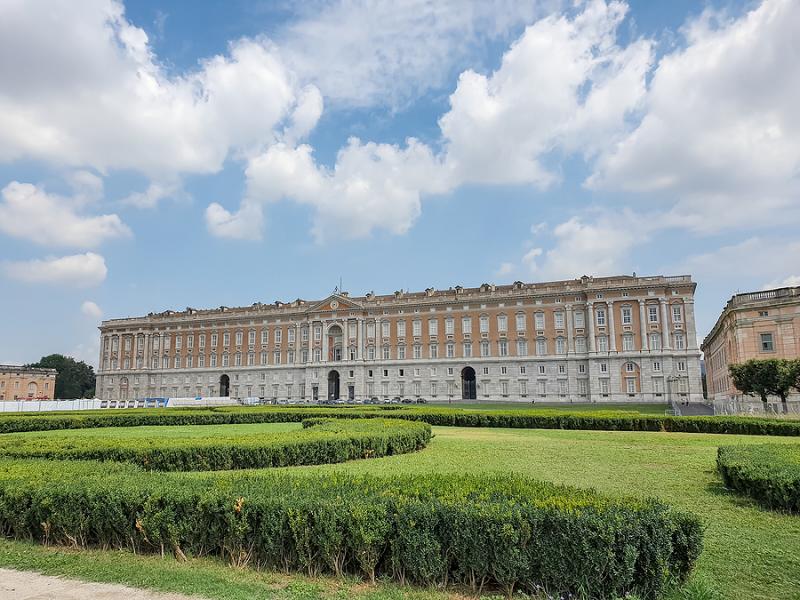Unesco Sites of Italy: 18th-Century Royal Palace at Caserta with the Park, Aqueduct and San Leucio Complex
ITA:

The monumental complex at Caserta was built by the architect Luigi Vanvitelli for the Bourbon king Charles III in the mid-18th century to rival Versailles and the Royal Palace in Madrid.
The site, inscribed by Unesco in its World Heritage list in 1997, comprises a magnificent palace with its park and gardens, natural woodland, hunting lodges, as well as the Aqueduct Carolino and the industrial complex of San Leucio, built for the production of silk.
The Palace is the centerpiece of the architectural complex, set on a central axis that connects and unifies it. “With its four courtyards and three atriums, the Royal Palace is a great example of monumental structure built to be a magnificent palace for the royal family and its court and, at the same time, an administrative center inspired by the model of Escorial in Spain,” writes Unesco.
The portico and the stream produced by the fountains in the park, which lead to the scenic backdrop of the waterfall, formed by the Aqueduct Carolino, are situated along the central axis.
The park is the last of the great European formal gardens inspired by Versailles and the 16-century models of Roman and Tuscan villas. The English Garden is one of the oldest and most important examples of landscape garden created in Europe.
The main part of the San Leucio estate is the ancient hunting lodge, converted by King Ferdinando IV of Bourbon into a silk mill to create an idealistic community of workers, who were guaranteed homes, schools, medical care and all services.
Finally, the Aqueduct Carolino is a stunning work of engineering, which not only served the palace and the gardens, but also the mills, the ironworks and manufacturing industries located along its path, as well as Naples.
Il complesso monumentale di Caserta fu costruito dall'architetto Luigi Vanvitelli per il re Borbone Carlo III a metà del XVIII° secolo per rivaleggiare con Versailles e il Palazzo Reale di Madrid.
Il sito, iscritto dall'Unesco nella Lista del Patrimonio Mondiale nel 1997, comprende un magnifico palazzo con parco e giardini, un bosco naturale, casino di caccia, nonché l'Acquedotto Carolino e il complesso industriale di San Leucio, costruito per la produzione della seta.
Il Palazzo è il fulcro del complesso architettonico, posto su un asse centrale che collega e unifica il complesso. “Con i suoi quattro cortili e tre atri, il Palazzo Reale è un ottimo esempio di struttura monumentale costruita per essere un magnifico palazzo per la famiglia reale e la sua corte e, allo stesso tempo, un centro amministrativo ispirato al modello dell'Escorial in Spagna”, scrive l'Unesco.
Lungo l'asse centrale sono situati il portico e il ruscello prodotto dalle fontane del parco, che immettono nella scenografica cornice della cascata, formata dall'Acquedotto Carolino.
Il parco è l'ultimo dei grandi giardini formali europei ispirati a Versailles e ai modelli cinquecenteschi di ville romane e toscane. Il Giardino Inglese è uno dei più antichi e importanti esempi di giardino paesaggistico realizzati in Europa.
La parte principale della tenuta San Leucio è l'antico casino di caccia, convertito dal re Ferdinando IV di Borbone in un mulino per la produzione di seta e creare una comunità idealistica di lavoratori, a cui fossero garantite case, scuole, cure mediche e tutti i servizi.
Infine, l'Acquedotto Carolino è una splendida opera di ingegneria, che non solo ha servito il palazzo e i giardini, ma anche i mulini, le ferriere e le industrie manifatturiere situate lungo il suo percorso, oltre che Napoli.











